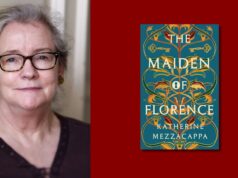
Read an extract from Dublin’s Graftonia: A Very Literary Neighbourhood, by Brendan Lynch

Dublin’s Graftonia describes Ireland’s key literary movements and the generations of writers from Jonathan Swift to George Bernard Shaw and Flann O’Brien, all of whom plied their trade on or near Dublin’s Grafton Street.
Bloomsday mid-afternoon outside Duke Street’s overflowing hostelries. Faces were flushed, straw hats tilted precariously, the tide was on the turn.
“Grafton Street a literary hub? You’re some joker,” a fellow-celebrant expostulated.
‘“Graftonia”, Paddy Kavanagh’s title for the demesne, reminds me of Soho in the 50s. Spivs hocking handbags for thousands, shite food emporiums on every corner, flower vendors who’ll declaim in fluent French as quick as they’ll look at you.
“Here on Duke Street, you’d have to mortgage the homestead to buy an early edition of Ulysses. Right here where Joyce begged a friend to bring him a pair of boots the 1904 night he fled the gaff with Nora. Literary hub my royal Irish…”
“Did you know that Grafton Street sits on the banks of the river Stein?”
“Many steins around today, go easy on that sherbet.”
The Bloomsday imbiber is not the only one unaware of Graftonia’s association with the Stein. And with key literary movements and generations of writers from Jonathan Swift to George Bernard Shaw and Flann O’Brien. Literary history illuminates every corner of the area. James Joyce made his print debut at 37 Stephen’s Green. Best-selling novelist Samuel Lover, grandfather of songwriter Victor Herbert, was born at 60 Grafton Street. A chance meeting at number 116 between W B Yeats and retired revolutionary John O’Leary ignited the Irish Literary Revival.
Grafton Street was awash with literary journals. Published at number 116, the Dublin University Review launched the careers of Oscar Wilde and W.B Yeats. The rival Dublin University Magazine serialised the early books of Gothic novelist Charles Lever, precursor of Bram Stoker, and provided James Clarence Mangan with a much-needed outlet. The Irish Quarterly Review and Exshaw’s Gentleman’s Magazine featured poets Thomas Moore and Thomas Davis. Published at number 39 in the late 1940s, Envoy magazine saw The Ginger Man author J.P Donleavy in print for the first time, and also published Patrick Kavanagh and Brendan Behan.
The area welcomed such distinguished visitors as Charles Dickens, Rudyard Kipling and poet Percy Bysshe Shelley, who lived at 17 Grafton Street in 1812. And Samuel Whyte, born near Liverpool, who opened Whyte’s Academy at number 75 in 1758. His graduates included ‘Bard of Ireland’, Thomas Moore and Richard Brinsley Sheridan, whose plays took late eighteenth century London by storm and earned him a final resting place in Poets’ Corner, Westminster Abbey.
Graftonia boasted Dublin’s two main seats of learning, Trinity College and the Catholic University, subsequently titled University College Dublin. Traversing its streets, one is walking in the footsteps of some of the greatest names in English literature and theatre. Trinity’s graduates range from Jonathan Swift and William Congreve to Oscar Wilde, Oliver St John Gogarty and Nobel Laureate, Samuel Beckett. Stephen’s Green’s Catholic University boasts James Joyce, social reformer Francis Skeffington and author and MP, Tom Kettle.
Renamed UCD and moved to nearby Earlsfort Terrace, it produced such writers as Kate O’Brien, Mary Lavin, Colm Tóibín and Brian O’Nolan, better known as Flann O’Brien.
In contrast to its well-ordered Georgian neighbours, 500-metre-long Grafton Street resembles a river with many tributaries, as it leisurely descends past a succession of side streets to sea-level at Trinity College. An apt comparison as, unknown to most Dubliners, it follows the course of the long-hidden and equally circuitous river Stein. Rising near Charlemont Bridge, the two and a half-kilometre-long waterway traverses the heart of Graftonia, as it meanders to Burgh Quay via Stephen’s Green, Grafton Street and the grounds of Trinity College.
Culverted in 1662, when William Hawkins built the south bank sea wall, locals had a reminder of the Stein’s presence when 1840s storms and a tidal surge flooded Lower Grafton Street basements opposite Trinity College.












